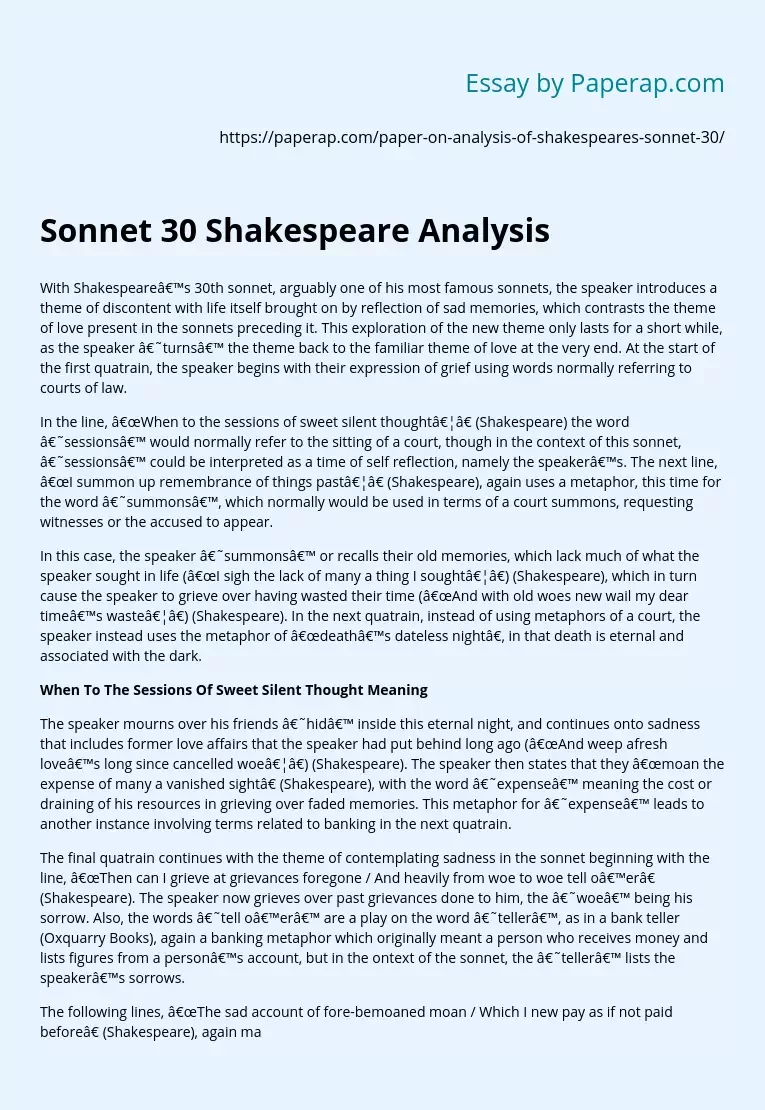Sonnet 30 Shakespeare Analysis
With Shakespeare’s 30th sonnet, arguably one of his most famous sonnets, the speaker introduces a theme of discontent with life itself brought on by reflection of sad memories, which contrasts the theme of love present in the sonnets preceding it. This exploration of the new theme only lasts for a short while, as the speaker ‘turns’ the theme back to the familiar theme of love at the very end. At the start of the first quatrain, the speaker begins with their expression of grief using words normally referring to courts of law.
In the line, “When to the sessions of sweet silent thought…” (Shakespeare) the word ‘sessions’ would normally refer to the sitting of a court, though in the context of this sonnet, ‘sessions’ could be interpreted as a time of self reflection, namely the speaker’s. The next line, “I summon up remembrance of things past…” (Shakespeare), again uses a metaphor, this time for the word ‘summons’, which normally would be used in terms of a court summons, requesting witnesses or the accused to appear.
In this case, the speaker ‘summons’ or recalls their old memories, which lack much of what the speaker sought in life (“I sigh the lack of many a thing I sought…”) (Shakespeare), which in turn cause the speaker to grieve over having wasted their time (“And with old woes new wail my dear time’s waste…”) (Shakespeare). In the next quatrain, instead of using metaphors of a court, the speaker instead uses the metaphor of “death’s dateless night”, in that death is eternal and associated with the dark.
When To The Sessions Of Sweet Silent Thought Meaning
The speaker mourns over his friends ‘hid’ inside this eternal night, and continues onto sadness that includes former love affairs that the speaker had put behind long ago (“And weep afresh love’s long since cancelled woe…”) (Shakespeare). The speaker then states that they “moan the expense of many a vanished sight” (Shakespeare), with the word ‘expense’ meaning the cost or draining of his resources in grieving over faded memories. This metaphor for ‘expense’ leads to another instance involving terms related to banking in the next quatrain.
The final quatrain continues with the theme of contemplating sadness in the sonnet beginning with the line, “Then can I grieve at grievances foregone / And heavily from woe to woe tell o’er” (Shakespeare). The speaker now grieves over past grievances done to him, the ‘woe’ being his sorrow. Also, the words ‘tell o’er’ are a play on the word ‘teller’, as in a bank teller (Oxquarry Books), again a banking metaphor which originally meant a person who receives money and lists figures from a person’s account, but in the ontext of the sonnet, the ‘teller’ lists the speaker’s sorrows.
The following lines, “The sad account of fore-bemoaned moan / Which I new pay as if not paid before” (Shakespeare), again make use of banking metaphors. ‘Account’ in the banking sense refers to a person’s bank account, but in this case, refers to the speaker’s record of grievances, and the speaker’s ‘paying’ of these grievances refers not to money being used to pay debits, but the paying of past grievances with the speaker’s sadness. Thankfully for the speaker, the couplet of the sonnet turns the theme back to one of love for their friend, with the speaker’s ‘losses’ being restored, another metaphor which refers back to the metaphors used in courts in the first quatrain.
The use of the word ‘restoration’ would normally be reserved for a legal settlement, in this case, the speaker’s ‘losses’ are his mood (one of sadness) being lifted up and ‘restored’ to a happy state. Through the use of metaphors and plays on words, Shakespeare is able to introduce and develop a new theme of sadness in his 30th sonnet, and through a turn in the final couplet, restores the theme of love for a friend which is found throughout Shakespeare’s collection of sonnets.
Works Cited
- Shakespeare, William. “Sonnet 30. ” The Norton Anthology of English Literature. Ed. M. H. Abrams et al. 6th. Ed. The Major Authors. New York: Norton, 2000 The amazing web site of Shakespeare’s Sonnets. October 13, 2007. Oxquarry Books Ltd. January 2007. ; http://www. shakespeares-sonnets. com/xxxcomm. htm;.
Sonnet 30 Shakespeare Analysis. (2019, Dec 05). Retrieved from https://paperap.com/paper-on-analysis-of-shakespeares-sonnet-30/

